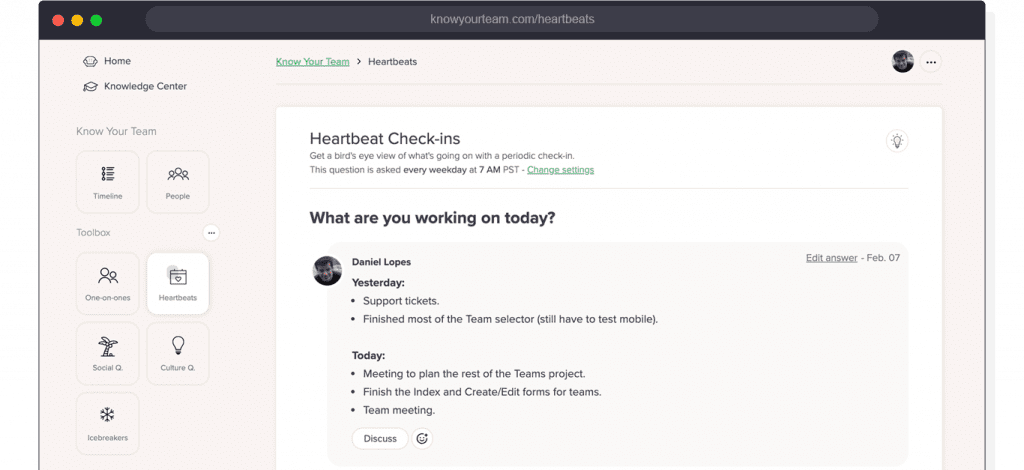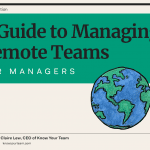With remote leadership, it’s easy to succumb to management practices that hurt our team. Here’s how to avoid doing so.

I’m deeply troubled: Remote leadership can bring out the worst in us as leaders if we’re not mindful.
Let me explain.
Amidst COVID-19 with more teams are becoming remote than ever before, leaders who are working from home for the first time are trying to navigate the transition.
One reaction to moving to remote leadership? The title of this article in Bloomberg says it all: “Bosses panic-buy spy software to keep tabs on remote workers.”
Reading the article was like entering a time warp where 18th-century factory management practices had been resurrected. Sixteen-hour workdays enforced by technology under the guise of “productivity.” Or perhaps it was a jump forward: A manifestation of an Orwellian dystopia where constant surveillance had become the norm. Managers asking staff to “stay logged into a video call all day while they work.” Leaders installing software that takes screenshots on employees’ computers “every 10 minutes or so.”
All are the makings of a bad dream that I want to wake up from. Perhaps you do too.
Are you contributing to the bad dream?
As you’re reading this right now, working from home as a manager, it’s likely this thought has crossed your mind at some point:
“I wonder if the rest of my team is actually working?”
After all, you’re used to “seeing” people be productive in the office. Meetings are happening. Energy is flowing.
And now? It’s Slack messages, Zoom video meetings… and that’s it. (And of course, your dog yapping or kids piping up in the background.)
You’re worried if it’s “enough.” You concerned about the work getting done. You want your team’s objectives to be met.
So what do you do?
You apply pressure. You drop a “What’s the status on XX?” in Slack as often as your anxious brain thinks the thought. You expect people to respond within 10 minutes and to be accessible by email at night. You hold more meetings to “just make sure folks are on task.” Perhaps you even purchase employee tracking software…
The irony is that this pressure massively backfires when it comes to remote work (and work, in general). The psychologist Edward Deci, who spent 20+ years researching human motivation, observed that several side effects when you try to exert control onto others: (1) The person’s performance goes down (2) the outcome suffers (3) the person doesn’t learn as much and (4) the person doesn’t enjoy the task, itself, as much.
And so, as you hover over your team and apply pressure on them – yes, you may achieve your goals in the short-term. But in the long-run? You disintegrate the whole purpose of having a team in the first place: To enable the capacity to accomplish things you wouldn’t be able to accomplish on your own.
You are left with shadows of people going through the motions of doing the work, not because they care about the work itself or the purpose behind the work – but because you’re breathing down their necks.
How to get remote leadership right
If we don’t want remote leadership to bring out the worst in us, what can we do? Here are five recommendations…
Notice when you’re reacting to feeling a lack of control.
Recognize that the pressure you apply is a reaction to a construct of control. You think you can control people – and things – and the reality is you can’t. The quicker you can realize this, the sooner you can shift to a frame of mind where you can focus constructively on the things that actually help your team, such as: (1) Making it clear why the work matters (2) Creating milestones to help that person achieve that work (3) Giving as much context as possible so they can make the best decisions (4) Helping them think through tough problems they encounter.
I dive deep on how to coach your employees in this way in our Workshop Live! session recording, “How to Coach an Employee.” (You can access it when you upgrade to the full version of Know Your Team.)
Remember: Time applied does not equate to progress made.
As a remote manager, you have to kill that paranoid voice inside that asks, “Is my team working?” You can never answer that wholly, even when you are in-person. So why burden your mind with it in a remote environment?
Rather, instead of enveloping yourself in uneasiness, remind yourself that you want to concentrate on the results. And, the path to results is creating the best environment for a person to achieve those results.
Effective remote leadership – or leadership, period, for that matter – is trusting that the team you picked, and you hired, and you chose, can follow-through on the job.
Otherwise, you create an environment where “looking busy” is more important than doing the work in reality. For example, I’ve known employees to spend more time preparing for meetings to show their boss that their working, than spending the time on the work itself. Are you guilty of this?
Make expectations absurdly obvious.
Oftentimes, we resort to tracking and imposing pressure on our team when we haven’t established clear expectations on how everyone is supposed to communicate and collaborate remotely.
This is your job as a remote leader. You need to make clear what the proper channels of communication and modes of work are. Specifically, here are some key questions you’ll want to answer for your team:
- What time zones is everyone working in? How will this be communicated?
- What are the expected working hours each person has? What should the overlapping working hours for folks in different time zones be?
- If you need to be offline to run an errand or are in a meeting, how will that be communicated?
- How will it be communicated when someone is sick or feeling unwell?
- Are there any times team members should not be disturbed?
- What’s the expected response time to messages? Does that vary depending on what the message is, or the channel that it is delivered in?
When you answer these questions for your team, these expectations should be made absurdly obvious. Here are some examples of remote teams (us included!) on how they document these expectations so they are indeed absurdly obvious:
- Know Your Team’s How We Work
- Basecamp’s How We Work
- Buffer’s 10 Slack Agreements
- GitLab’s Remote Communication Handbook
- Automattic’s Communication Expectations
The more you can illuminate “this is what effective work in our team will look like,” the more probable it is that vision will become reality.
Enable your team to proactively share progress.
Every time you ping an employee, “What’s the status on XX?”, you throw them off their work. They halt their progress, feel anxious, and scramble to indeed prove to you that, “Yes, I’m working and everything is on track.”
Rather than disrupt folks in this way, give your team an adequate opportunity to proactively share progress with you. When you do this, you enable the person to share with you on their own schedule, out of their own volition, what they’re working on.
We use our Heartbeat Check-in at Know Your Team for this. Every morning, via Slack or email, a check-in is sent out that asks, “What did you work on yesterday, and what are you working on today?” Team members (including you!) can fill the Heartbeat out that day when it best suits them. After they respond, the answers are shared with everyone. No one is interrupted. And everyone – not just you as the leader – get to benefit from seeing the answers.

No longer are you interrogating employees to “make sure” they are being productive. When you give the team an opportunity to proactively progress, that progress can now happen.
Hold regular weekly or biweekly one-on-one meetings.
One-on-one meetings are potentially your most critical tool for you in remote leadership. But only if you hold them in the right way.
In 2018 survey we conducted of 1,182 managers and 838 employees, we found 40% of employees think their manager is “not prepared” or “not prepared at all” for their one-on-one meetings.
To do remote leadership well, it’s time to change that. To prepare for your one-on-one meetings, first make sure your one-on-one meetings are not status updates. You can do that through our Heartbeats Check-in (or Slack, email, etc.) Rather, one-on-one meetings are invaluable time for you as a leader to understand how an employee is feeling, so you best support them through remote work. You can help a team member overcome blockers, think a hard problem through, and make better progress – all in an effective one-on-one meeting.
To do this, here’s a one-on-one meeting agenda template that you can use during these tough times of COVID-19 and their transition to remote work:
Catching up (5 min.)
- How are you feeling with all the uncertainty lately?
Concerns / Issues (20 min.)
- How do you feel about the workload? Where is it unreasonable?
- Is there anything that feels troubling or concerning to you about the direction of the team?
Feedback (20 min.)
- How are you feeling about this transition to remote work? Anything I can help make more clear?
- What about my management style can I improve or adapt, to best support you during these times?
Takeaways / Next Steps (5 min.)
Find this agenda template helpful? We give you hundreds of one-on-one meeting question suggestions and agenda templates with our One-on-Ones Tool in Know Your Team. You may want to check it out today.
Additionally, I’ve written an extensive “Guide to Effective One-on-One Meetings” based on data with 2,000+ people, that is available when you sign up for and upgrade to the full version of Know Your Team.
The time warp doesn’t have to happen. We don’t have to devolve our management practices to be more primitive or dystopian in an effort to “ensure productivity.”
Rather, we can do remote leadership the right way. We can default to trust – not tracking. We can focus on how we’re supporting our remote employees, not inadvertently holding them back. This the opportunity we have, with remote leadership. Let’s rise to it.
🌎 Ready to get remote leadership right? You’ll want to use Know Your Team to help. Remote managers all over the world use KYT to run effective one-on-one meetings, get honest feedback, share team progress, and build team rapport. Try Know Your Team for free, yourself, today.
Looking for additional remote resources? Don’t miss these here:



